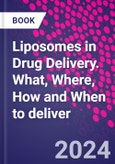Liposomes in Drug Delivery: What, Where, How and When to Deliver is a concise, well-structured reference covering all the important issues related to the potential of this technology. Organized to provide practical information to researchers from any discipline with a particular therapeutic or bio-active substance to deliver, this book helps readers understand if liposomes can be of benefit for their particular need, what is the best type of liposome to use according to what needs to be delivered, where/when to deliver it, and how to design/prepare/characterize/investigate/optimize liposome properties for a particular application.
The book is structured in Four parts. The first covers in a concise but in-depth way, what liposomes are, which are the liposome types, advantages/disadvantages, and what is their stability, characterization methods, in vitro stability, and in vivo fate after different administration methods (routes). The second part focuses on the different mechanisms for liposomal drug delivery. Methodologies/technologies for manipulation of liposome structure/properties in order to design liposomes for particular delivery applications. Specific roadmaps for liposome design are discussed, including components to incorporate in liposomes for specific types of encapsulated molecules or specific routes of administration. The third part covers liposome applications for drug delivery. It focuses on specific delivery considerations for particular diseases. Finally, the fourth part covers methods of liposome fabrication.
Please Note: This is an On Demand product, delivery may take up to 11 working days after payment has been received.
Table of Contents
Part I Basic concepts of Liposome-Assisted Drug Delivery1. Introduction to Liposome Assisted Drug Delivery
2. Basic concepts of Liposome: components, structures, properties and classification
3. Liposome Characterization Methodologies(Physical and Chemical Methods)
4. Liposome Characterization Methodologies Morphological Assessments by Microscopy
5. Liposome Stability and Integrity
6. In vivo fate of Liposomes: Biodistribution and cell membrane interactions
Part II Mechanisms of Liposome Drug Delivery
7. Liposomes in controlled drug delivery: Controlling drug release kinetics and biodistribution/pharmacokinetics
8. Liposome surface modifications-Engineering techniques
9. Activatable liposomes: Ultrasound-activated liposomes and lipid vesicles
Part III Liposome Applications in drug delivery
10. Liposomes for drug delivery to the brain
11. Liposomes for drug delivery to cancer cells
12. Liposomes as vaccine delivery systems
13. Liposomes as DNA, mRNA and oligonucleotide delivery vectors
14. Liposomes for drug delivery by localized routes of administration
15. Liposome for drug delivery against infectious diseases
16. Liposomes for drug delivery via biomaterials
17. Liposomes for delivery of substances for other (non-therapeutic) applications
Part IV -Liposome fabrication
18. Conventional methods for preparing liposomes of various types (MLVs, LUVs, SUVs )
19. Size reduction, purification, sterilization and storage/packaging of Liposomes
20. Methods for preparation of Giant liposomes: Conventional methods; Modified electro-techniques
21. Microfluidic methods for liposome formation
22. Supercritical fluids and other novel methods for liposome formation
23. Design of experiment approaches for liposome property optimization
24. Development of generic liposome products for drug delivery
Part V Conclusions and Perspectives
25. Success stories, Final remarks and directions of the field
Authors
Sophia G. Antimisiaris Professor, Department of Pharmaceutical Technology, Department of Pharmacy, University of Patras, Rio-Patras, Greece. Collaborating Professor, Institute of Chemical Engineering Sciences, Foundation for Research and Technology Hellas (FORTH/ICES), Platani-Patras, Greece..Professor Antimisiaris' lab has extensive experience (more than 25 years) in design and production of liposomal and lipid/polymer/cyclodextrin hybrid nanoparticulates for drug and/or imaging agent delivery and targeting to specific target cells. Several administration routes have been investigated or are under investigation in regards to the specific requirements of liposomes for each specific route (such as: iv, ip, oral, lung/intrapleural, ocular/intravitreal, vaginal, etc.). Her laboratory also has long term collaborations with industries and is involved in development of new products. She has experience as coordinator and/or WP-leader in several large scale European Collaborative Projects, as Shiva (FP6), for development of liposomal microbicides for vaginal delivery, NAD (FP7, Nanoparticles for diagnosis and Therapy of AD), for design and development of liposomes s with affinity for Abeta peptides, SBR (Smart Bone Regeneration, H2020), for development of liposomal growth factors integrated in biomaterials. Her team have also been working for many years on the application of arsonolipid-containing liposomes for therapy of cancer with promising in vitro and in vivo results. They also investigate the development of novel platforms for sustained release of drugs following ocular/intravitreous, vaginal, intrapleural or subcutaneous administration.








